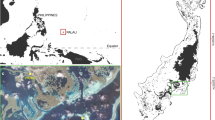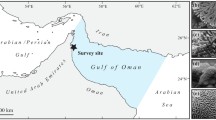Abstract
Coral spawning in Western Australia (WA) occurs predominantly in the austral autumn in contrast to the Great Barrier Reef (GBR) on Australia’s east coast where most spawning occurs in spring. Recent work, however, suggests a second spawning period in northern WA with at least 16 Acropora spp spawning in spring or early summer. This discovery has initiated a re-examination of reproductive seasonality in northern WA, particularly on inshore reefs adjacent to large development projects, such as the site of this study in Mermaid Sound, in the Dampier Archipelago. Three locally abundant taxa, Porites spp, Pavona decussata and Turbinaria mesenterina were sampled monthly from September 2006 to May 2007 to determine sexuality, the mode of reproduction and the time of gamete maturity. All three taxa were gonochoric broadcast spawners. Porites spp. colonies were mature in November and December, P. decussata in March and April. In contrast, most colonies of T. mesenterina contained mature gametes for up to 5 months beginning in November, suggesting either individuals are releasing gametes on multiple occasions, or they retain mature gametes for more than 1 month. Field surveys to determine the reproductive status of the remaining coral assemblage were conducted prior to the full moon in October 2006 and March 2007. Only four species contained mature gametes in October 2006. In contrast, 55 species contained mature gametes in March 2007. We conclude that the major spawning season of corals on shallow-inshore reefs in the Dampier Archipelago is autumn, although taxa that spawn in spring and summer include Porites spp., Acropora spp. and possibly T. mesenterina that are numerically dominant at many of these sites. Consequently, management initiatives to limit the exposure of coral spawn to stressors associated with coastal development may be required in up to five months per year.







Similar content being viewed by others
References
Babcock RC, Bull GD, Harrison PL, Heyward AJ, Oliver JK, Wallace CC, Willis BL (1986) Synchronous spawnings of 105 scleractinian coral species on the Great Barrier Reef. Mar Biol 90:379–394
Babcock RC, Willis BL, Simpson CJ (1994) Mass spawning of corals on a high-latitude coral-reef. Coral Reefs 13:161–169
Babcock RC, Baird AH, Piromvaragorn S, Thomson DP, Willis BL (2003) Identification of scleractinian coral recruits from Indo-Pacific reefs. Zool Stud 42:211–226
Baird AH, Guest JR (2009) Spawning synchrony in scleractinian corals: comment on Mangubhai and Harrison (2008). Mar Ecol Prog Ser 374:301–304
Baird AH, Sadler C, Pitt M (2001) Synchronous spawning of Acropora in the Solomon Islands. Coral Reefs 19:286
Baird AH, Marshall PA, Wolstenholme J (2002) Latitudinal variation in the reproduction of Acropora in the Coral Sea. Proceedings of the 9th International Coral Reef Symposium I, pp 385–389
Baird AH, Birrell CL, Hughes TP, McDonald A, Nojima S, Page CA, Pratchett MS, Yamasaki H (2009a) Latitudinal patterns in spawning synchrony in the Acropora: Japan vs the Great Barrier Reef. Galaxea 11:101–108
Baird AH, Guest JR, Willis BL (2009b) Systematic and biogeographical patterns in the reproductive biology of scleractinian corals. Annu Rev Ecol Syst 40:531–571
Baird AH, Kospartov MC, Purcell S (2010) Reproductive synchrony in Acropora assemblages on reefs of New Caledonia. Pac Sci 64:405–412
Blakeway D, Radford BTM (2004) Scleractinian corals of the Dampier Port and inner Mermaid Sound: species list, community composition and distributional data. In: Stoddart JA, Stoddart SE (eds) Corals of the Dampier Harbour: their survival and reproduction during the dredging program of 2004. Mscience Pty Ltd, Perth, pp 1–12
Gilmour JP, Smith LD, Brinkman RM (2009) Biannual spawning, rapid larval development and evidence of self-seeding for scleractinian corals at an isolated system of reefs. Mar Biol 156:1297–1309
Glynn PW, Colley NJ (2009) Survival of brooding and broadcasting reef corals following large scale disturbances: is there any hope for broadcasting species during global warming? Proceedings of the 11th International Coral Reef Symposium, pp 361–365
Harriott VJ (1983) Reproductive ecology of four scleractinian species at Lizard Island, Great Barrier Reef. Coral Reefs 2:9–18
Harrison PL, Wallace CC (1990) Reproduction, dispersal and recruitment of scleractinian corals. In: Dubinsky Z (ed) Coral Reefs. Elsevier, Amsterdam, pp 133–207
Harrison PL, Babcock RC, Bull GD, Oliver JK, Wallace CC, Willis BL (1984) Mass spawning in tropical reef corals. Science 223:1187–1188
Kojis BL, Quinn NJ (1982) Reproductive strategies in four species of Porites (Scleractinia). Proceedings of the 4th International Coral Reef Symposium 2, pp 145–151
Marshall SM, Stephenson TA (1933) The breeding of reef animals. Part I. The corals. Sci Rep Gt Barrier Reef Exp 3:219–245
Oliver JK, Babcock RC, Harrison PL, Willis BL (1988) Geographic extent of mass coral spawning: Clues to ultimate causal factors. In: Proceedings of the 6th International Coral Reef Symposium 2, pp 803–810
Plathong S, Chanmethakul T, Suwonno V, Buaphet P, Baird AH, Chen CA, Soontornpitakkool S (2006) Daytime gamete release from the reef-building coral, Pavona sp., in the Gulf of Thailand. Coral Reefs 25:72
Rosser NL, Baird AH (2009) Multi-specific coral spawning in spring and autumn in far north-western Australia. Proceedings of the 11th International Coral Reef Symposium, pp 366–370
Rosser NL, Gilmour JP (2008) New insights into patterns of coral spawning on Western Australian reefs. Coral Reefs 27:345–349
Simpson CJ (1985) Mass spawning of scleractinian corals in the Dampier Archipelago and the implications for management of coral reefs in Western Australia. Dept. Conservation and Environment Western Australia Bulletin, 244, Perth
Szmant-Froelich A, Reutter M, Riggs L (1985) Sexual reproduction of Favia fragum (Esper): Lunar patterns of gametogenesis, embryogenesis and planulation in Puerto Rico. Bull Mar Sci 37:880–892
Vargas-Angel B, Colley SB, Hoke SM, Thomas JD (2006) The reproductive seasonality and gametogenic cycle of Acropora cervicornis off Broward County, Florida, USA. Coral Reefs 25:110–122
Willis BL (1987) Morphological variation in the reef corals Turbinaria mesenterina and Pavona cactus: synthesis of transplant, histocompatibility electrophoresis, growth and reproduction studies. Phd Thesis. Department of Marine Biology, Townsville
Willis BL, Babcock RC, Harrison PL, Oliver JK (1985) Patterns in the mass spawning of corals on the Great Barrier Reef from 1981 to 1984. Proceedings of the 5th International Coral Reef Symposium 4, pp 343–348
Acknowledgments
We thank Woodside Energy Ltd and Pilbara Iron Pty Ltd for funding this project. N. Rosser, J Eagle and three anonymous reviewers provided valuable comments on the manuscript.
Author information
Authors and Affiliations
Corresponding author
Additional information
Communicated by T. L. Goulet.
Appendices
Appendix 1
See Table 5.
Appendix 2
See Table 6.
Rights and permissions
About this article
Cite this article
Baird, A.H., Blakeway, D.R., Hurley, T.J. et al. Seasonality of coral reproduction in the Dampier Archipelago, northern Western Australia. Mar Biol 158, 275–285 (2011). https://doi.org/10.1007/s00227-010-1557-7
Received:
Accepted:
Published:
Issue Date:
DOI: https://doi.org/10.1007/s00227-010-1557-7




